The beginnings of the American labor movement
In the early years of the republic, efforts by tradesmen to create better conditions by refusing to work and trying to prevent others from working were considered criminal offenses. Journeymen boot-makers and shoe-makers were put on trial in Philadelphia in 1806 and convicted of criminal conspiracy. This set the standard attitude towards organized work disruptions until 1842, when the principle of criminal conspiracy was rejected by the Supreme Court of Massachusetts.
The New York Workingmen's Party lasted only a short time, formed in 1829 and disappearing in 1830. However, it publicized a new goal, the reduction of daily time of labor to ten hours. Since the work week was still six days, this radical demand was for no more than sixty hours of work a week.
In 1833, journeymen carpenters struck for higher wages and were supported by contributions from other tradesmen until their demands were met. Out of this combination arose the General Trades' Union of New York. The attitude of business was negative, as can be seen in this excerpt from an article in the New York Journal of Commerce in June of that year:
But according to our notions of the obligations of society, all combinations to compel others to give a higher price or take a lower one are not only inexpedient but at war with the order of things which the Creator has established for the general good, and therefore wicked. ...The first crack in the judicial opposition to trade union actions came in Connecticut in 1836. In 1834, the Thompsonville Carpet Manufacturing Company sued some labor leaders for damages, asserting that by refusing to work and persuading others not to work, they were conspiring to the ruin the company. After two inconclusive trials, the defendants were acquitted after the jury was instructed that simply combining efforts to raise wages was not per se illegal.
By 1836, the ten-hour work day was the norm for organized laborers along the Eastern seaboard. On federal government job sites, however, the daily schedule was still twelve hours. Starting in 1835, workers at the Brooklyn navy yard began to agitate for a ten-hour day, leading to a successful strike in 1836. Seeing this example, other federal workers pressed for the same consideration and in 1840, President Martin Van Buren made the ten-hour day standard for federal works.
Legislative recognition of the needs of the American laborer began in the Commonwealth of Massachusetts. The first Child Labor law (1836) was passed, whereby employment of children under the age of 15 was forbidden in incorporated factories, unless they had attended school for three months the prior year of their employment. The commonwealth's chief justice, Lemuel Shaw, ruled in the case of Commonwealth v. Hunt (1842), that a trade union was lawful and that its members were not collectively responsible for the illegal acts committed by individuals. Shaw also ruled that a strike for a Closed Shop was legal.
As farmers' sons, discharged soldiers, and a new wave of immigrants hit the industrialized cities in America, new labor problems arose. Newly educated women, schooled by one of the seven new women's colleges or private boarding schools between 1861 and 1880, joined the overabundance of workers in practically every occupation (except for stevedoring and the building trades) and in nearly every profession (except for the police and the ministry).
The government's willingness to intervene in dealing with poor working conditions in industrialized cities was greatly affected by the principles of laissez faire, which stated that “the functions of the state should be limited to internal police and foreign protection — no Public Education, no limitation of hours of labor, no welfare legislation.” Spencer, who published Social Statistics in 1865, also included the Darwinian principle of survival of the fittest to his dog-eat-dog ideology. Its effects included delays in factory inspections, passing laws limiting the number of hours worked, and laws prohibiting “sweatshops,” where families lived and worked in one-room “homes.”
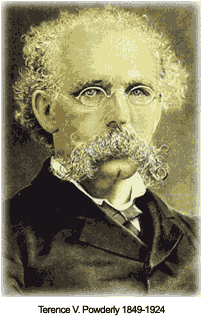 As the economy improved over the next few years, American labor took another direction: toward labor organizing. Several unions came into being, including the Order of the Knights of Labor. Founded in 1869, the Knights' goal was to to increase negotiating powers by unionizing all American workers.
As the economy improved over the next few years, American labor took another direction: toward labor organizing. Several unions came into being, including the Order of the Knights of Labor. Founded in 1869, the Knights' goal was to to increase negotiating powers by unionizing all American workers.
The Knights of Labor, under the leadership of Pennsylvania machinist Terence V. Powderly, were essentially responsible for the Alien Contract Labor Law of 1885, which prohibited laborers immigrating to America who had a contract to perform work. Since the law contained no enforcement provisions, such as inspections or deportation, the States were unable to enforce it.
Violence during the 1870s and '80s
Driven by wage cuts and poor working conditions, violent outbreaks of strikes and a long series of battles occurred all over the country during the 1870s. In 1877, around the coal mining region of Mauch Chunk and Pottsville, Pennsylvania, a secret miners' association called the Molly Maguires, mostly comprising Irish Catholics, burned buildings, controlled county officials, and murdered bosses and supervisors who offended them. Finally, the murderers were apprehended and brought to trial. The hanging of 10 of those men in 1877, effectively broke up the “Mollies.”
Also in 1877, unorganized railroad workers struck because of a 10 percent wage cut, the second cut since the Panic of 1873. They brought to a screeching halt four Eastern rail trunk lines, which caused turmoil in every industrial center. In Pittsburgh, Pennsylvania; Martinsburg, West Virginia; and Chicago, Illinois; the Great Strike of 1877 sparked battles between militia and the crowds. Only after federal soldiers were brought in, was ordered restored.
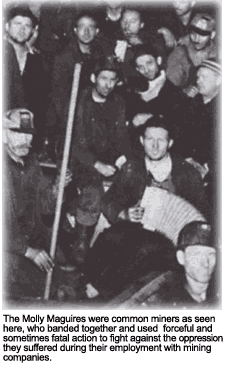 By 1886, membership in the Knights of Labor had swollen to 700,000 workers and stood as a champion for the unskilled laborer. Unlike other labor unions, the Knights of Labor encouraged blacks to join, so that by 1886, approximately 60,000 blacks had become members.
By 1886, membership in the Knights of Labor had swollen to 700,000 workers and stood as a champion for the unskilled laborer. Unlike other labor unions, the Knights of Labor encouraged blacks to join, so that by 1886, approximately 60,000 blacks had become members.
Blacks had been deemed unfit for manufacturing work, according to a “study” published by the Manufacturers Record of Baltimore in 1893. Such conclusions made it difficult for blacks to enter the industrial labor market.
The Knights of Labor participated in the famous Haymarket Square Riot of 1886 in Chicago, along with trade unions, socialist unions, and “anarchists,” where workers fought for the eight-hour day, and where a bomb and subsequent shooting resulted in the deaths of eight policemen and injuries to 67 others. Eight anarchists were jailed, tried, and convicted of murder, of which four were hanged. Then, due to mismanagement of operations, membership within that organization began to decline.
The American Federation of Labor (A.F. of L.) (now simply AFL) began that same year. The AFL was spearheaded by Samuel Gompers, a cigar maker by trade, who had learned of the economic struggles of the American laborer through conversations with cigar makers at the factory.
Gompers led AFL member unions and individual workers into struggles for shorter hours and higher wages. At first, blacks were openly encouraged to join the AFL, until it was later seen that their explicit stand on race issues hampered the union's expansion. Thereafter, as long as a union did not include anything in their constitution regarding the exclusion members because of race, those unions were welcome to join the AFL.
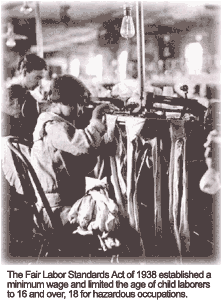 It was not until the Massachusetts' Ten-Hour Act (1874) went into effect that woman and child labor limits in factories were adequately enforced. But a New York act of 1883, which prohibited the manufacture of cigars in sweatshops, was overturned by the state's highest court, even though it had been sponsored by Theodore Roosevelt and signed by Governor Grover Cleveland.
The court declared that government should not force workers to leave their homes to go to work and and also should not interfere with the profitable use of real estate, without any compensation for the public good.
It was not until the Massachusetts' Ten-Hour Act (1874) went into effect that woman and child labor limits in factories were adequately enforced. But a New York act of 1883, which prohibited the manufacture of cigars in sweatshops, was overturned by the state's highest court, even though it had been sponsored by Theodore Roosevelt and signed by Governor Grover Cleveland.
The court declared that government should not force workers to leave their homes to go to work and and also should not interfere with the profitable use of real estate, without any compensation for the public good.
An Illinois court struck down a statute limiting the number of hours worked by women in sweatshops as unconstitutional, stating that women were “sufficiently intelligent to make their own labor contracts in their own interest.” During that time, the principles of laissez-faire still greatly affected the government's ability to intercede in labor disputes.
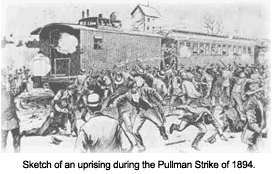 The Sherman Antitrust Act of 1890, which authorized federal action against any "combination in the form of trusts or otherwise, or conspiracy, in restraint of trade," was used as a blanket injunction against labor to break the current strike and others in the future. The Pullman Strike (1894) against the Great Northern Railway of Chicago, led by Eugene V. Debs, then president of the American Railway Union, was staged because of cuts in wages and continued high rents in company-owned housing. At the suggestion of Attorney General Richard Olney, President Cleveland ordered 2,500 federal troops to the strike zone and broke the strike within a week.
The Sherman Antitrust Act of 1890, which authorized federal action against any "combination in the form of trusts or otherwise, or conspiracy, in restraint of trade," was used as a blanket injunction against labor to break the current strike and others in the future. The Pullman Strike (1894) against the Great Northern Railway of Chicago, led by Eugene V. Debs, then president of the American Railway Union, was staged because of cuts in wages and continued high rents in company-owned housing. At the suggestion of Attorney General Richard Olney, President Cleveland ordered 2,500 federal troops to the strike zone and broke the strike within a week.
Concentrations of wealth by 1900
Mass concentration of wealth through acquisitions, such as one with J.P. Morgan to form the United States Steel Company in 1901, and the unbridled power of investment banking firms, led labor unrest to the doorstep of a population of one percent owning more national wealth than the other 99 percent.
U.S. Steel swallowed up 213 manufacturing plants and transportation companies, 41 mines, 1,000 miles of railroad track, 112 ore boats and more, to become an employer of 170,000 workers alone.
Between the years of 1897 and 1903, approximately half of America's families did not own property. And by 1900, 18 million of the 29 million made an annual wage of around $500, which was below the cost of living for a industrialized family of four, while ^Andrew Carnegie^ earned $23 million himself.
Life expectancy for whites was 48 years and nonwhites was only 34. The work force included 1.75 million children under 15 and more than five million women, who sometimes worked for as low as 10 cents for a 10-hour day. Those conditions, the dehumanization of the American laborer in large, and impersonal factories, led to numrous revolts and uprisings.
At the same time, minority workers began to take a more active role in the American labor movement. In 1900, at a Boston meeting of black businessmen, the National Negro Business League was organized. As their president, Booker T. Washington encouraged blacks in his publication, The Negro in Business, to start their own business enterprises and to frequent each others' establishments. By 1907, many local organizations were formed that joined the 320 branches of the Negro Business League.
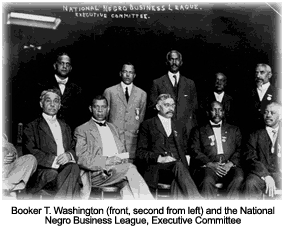 The proportion of British and Irish immigrants fell from 54 percent in 1870, to 18 percent in 1900. Immigration from Russia, Italy, and other southern European countries grew from .1 to 50 percent. By 1900, most of those foreign-born workers had settled in states north of the Ohio and east of the Mississippi River.
The proportion of British and Irish immigrants fell from 54 percent in 1870, to 18 percent in 1900. Immigration from Russia, Italy, and other southern European countries grew from .1 to 50 percent. By 1900, most of those foreign-born workers had settled in states north of the Ohio and east of the Mississippi River.
Because of the competition for work, wages were kept low, and the unions' ability to organize was hampered. Labor activist Mother Jones assisted in the formation of the the next big industrial union, the Industrial Workers of the World (IWW), in 1905. The New York Women's Trade Union League and a local of the International Ladies Garment Workers Union achieved positive results while enduring three months of cold weather, police abuse, and harassment by scabs during the 1909 Uprising of Twenty Thousand strike over sweatshops in New York City.
In 1913, attempts by Congress to limit immigration of illiterate workers, which was promoted by the unions, was vetoed by President William H. Taft, who wrote that illiteracy was not a test of character, since it is often due to a lack of opportunity.
That same year, at the Paint Creek-Cabin Creek strike in West Virginia during 1912-1913, workers violently struggled for improved working conditions. Jones organized a march with coal miners' children, which led to her arrest and later pardon. During the “Machine Gun Massacre” in a tent colony at Ludlow, Colorado (1914), strikers gained the attention of members of the House Mines and Mining Committee, as well as President Woodrow Wilson, who proposed that the union agree to a truce with the owners and to form a grievance committee at each mine.
As laissez faire influence began to wane, legislation was put into effect to support the needs of American labor. Gompers noted that the Clayton Antitrust Act (1914) was “Labor's charter of freedom.” The act included a section declaring that unions could not be considered unlawful combinations per se and that strikes, boycotting, and picketing were not violations of federal law.
The injunction — which was also used by President Cleveland to break up the Pullman Strike — could not be used in labor disputes by the federal courts. The Adamson Act of 1916 was initiated by President Wilson and proposed by Congress to avoid a nationwide railroad strike by four railroad unions. The act provided benefits, including the eight-hour day, to the railroad brotherhoods, while the Workers Compensation Act for Federal Employees was passed that same year.
As part of President Franklin D. Roosevelt's 100-day relief legislation, the National Industrial Recovery Act of 1933 was designed to encourage collective bargaining for unions, set up maximum work hours and sometimes prices, establish minimum wage standards, and prohibit child labor in industry. Before the act was overturned by the U.S. Supreme Court, 4,000,000 unemployed people had been absorbed into industrial jobs.
After the NRA was found unconstitutional, portions of the act were revived in the Wagner Act (1935), which established a federally appointed National Labor Relations Board (NLRB). That board was authorized to address labor complaints by issuing “cease and desist” orders against “unfair practices” in labor relations. Although strongly attacked by American business owners, the board received strong support from the Supreme Court, which, in case after case, sustained its existence.
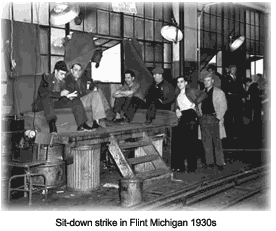 The labor movement during the Depression
The labor movement during the Depression
The emergence of the Congress of Industrial Organizations (C.I.O.), came as a result of worker's impatience with Sam Gompers' cautious policies. Hundreds of thousands of unskilled and semi-skilled laborers signed up with the only union they felt had their interests in mind.
By midsummer 1937, membership grew to an estimated 4,000,000 in the CIO Under the dynamic leadership of John L. Lewis of the United Mine Workers (UMW), the CIO unionized industries that had previously been opposed to it, such as the steel, automobile, textile, and public utilities.
Black workers also were encouraged to organize and participate in the membership of the CIO. Lewis ordered a series of strikes directed at securing the closed shop, establishing the CIO's exclusive right to represent workers in collective bargaining, and to defend his newly favored sit-down strike tactic.
In a sit-down strike, workers took possession of a premise and then refused to leave until demands were met. In March 1937, General Motors and Republican Steel contested the new sit-down's legality, calling for the Michigan courts to rescue their properties by ordering injunctions against sit-down protesters. Those actions caused a further rise in tension between the workers and factory owners, until Governor Frank Murphy's intervention successfully prevented widespread violence in the automobile industries.
Congress passed the Fair Labor Standards Act (1938), with the objective of the “elimination of labor conditions detrimental to the maintenance of the minimum standards of living necessary for health, efficiency, and well being of workers.”
Touted by President Roosevelt as “the most far-reaching, far-sighted program for the benefit of workers ever adopted,” the act eventually provided for the maximum work week of 40 hours and minimum wage of 40 cents an hour by 1945. Nearly 700,000 workers, including organized blacks, were affected by the wage increase. Some 13 million more workers were ultimately affected by the hours provision, although the act did not affect blacks working in the agricultural and domestic fields.
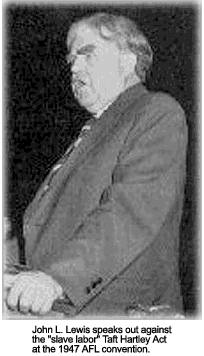 Labor after World War II
Labor after World War II
Post-World War II America brought new challenges to labor as production needs sharply decreased and overtime hours dried up. Instead of lowering wages following the war, companies reduced overtime hours, which had the effect of a 50 percent decrease in take-home pay. At the same time, Congress lifted the wartime Price Controls on basic commodities, which brought about price increases of 25 percent, causing “real wages” to decline by 12 percent in one year.
Renewed strikes for higher wages in the coal, automobile, steel, electric appliance, and railroad industries provoked a strong anti-union reaction from the public, which felt the unions had become arrogant and thankless for the favors received during the New Deal administrations.
Upon election of a Republican majority in both houses of Congress, the Taft-Hartley Act (1947) was passed over Democratic President Harry Truman's veto.
That anti-labor backlash act outlawed the closed shop, made unions liable for damages caused by breaches of contract, required a 60-day “cooling off period” before striking, forbade unions from making political contributions or extracting excessive dues, and required elected union officials to take an oath stating they were not Communists.
Outraged by the bill, Lewis and other labor leaders complained that the bill meant “slavery” and “fascism” to workers, which did not prove to be the case.
The good life of the 1950s
During the 1950s, life was good for the average American when “Middle American” values and prosperity saw the decline of unionism in the country. The American laborer worked fewer than 40 hours per week, while most received annual two-week vacations and had twice the income to spend as they had during the nation's previous economic boom time in the late Twenties. The domestic place of women continued to be encouraged, but it was not until the 1960s that alternatives became attractive.
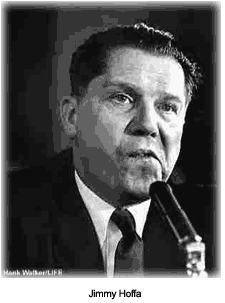 Tumultuous times of the 1960s
Tumultuous times of the 1960s
American labor unions were hurt by many problems during the 1960s, including migration of many industries into the anti-union southern states, the rapid expansion of the middle class, and internal corruption by some of the larger unions, such as the International Brotherhood of Teamsters.
Between 1955 and 1968, the percentage of unionized workers in non-agricultural employment declined from 33 to 28 percent. Union membership only slightly increased during a time when large corporations exercised greater influence in the stock market, military defense spending, increased prices on goods, thus promoting inflation and decision making concerning production, wages, and technical change.
Catering to the needs of their workforce, and to the expansion of their own wealth and power, those large corporations invested from $4 billion to $100 billion in 1965 in pension funds in the stock market. Once a great adversary of corporations, the labor unions were virtually complacent concerning the actions of big business.
Large unions used their clout to advance their own goals over those of their workers. After 1965, those well-organized unions, led by such leaders as Jimmy Hoffa and George Meany, tended to fragment the political parties, embattle the Congress, and to stymie Congress's efforts to heal the nation's racial, ethnic, and urban divisions.
Influx of immigrants in the 1970s and '80s
The economic gap widened between black and white workers, with 31 percent of blacks in poverty and 40 percent of teenage blacks unemployed in certain areas, during the late 1970s.
Modern immigrants during the 1980s — from such countries as Mexico, China, Japan, Korea, Vietnam, Cambodia, and India — steadily climbed the economic ladder by accepting low-paying jobs that non-immigrant Americans were disinclined to take.
That phenomenon put an added strain on American labor. Women continued to move into the work world, so that by 1987, 55 percent of women worked outside the home, while only 40 percent did so in 1966. Women's rights activists fought for improvements in working conditions, including better provisions for maternity leave, increased public funding for day care, and legislation for child-care costs to be made tax deductible.